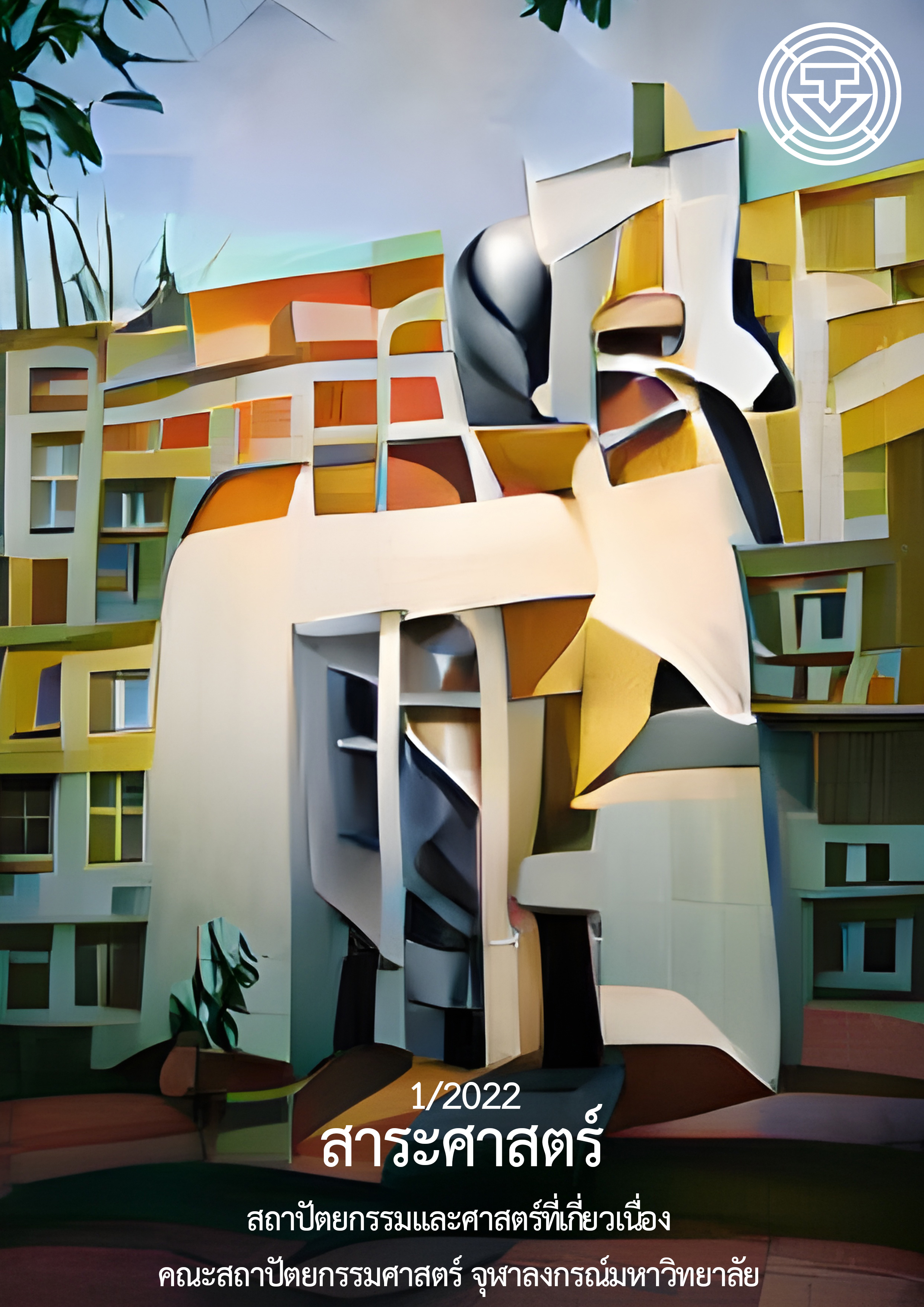Living Conditions Elderly People in Housing Estate a Case Study of Nantawan Housing Estate
Main Article Content
Abstract
Due to the continued growth of the elderly population, most of the research in the elderly is related to the elderly in the community or the elderly on low incomes. Therefore, this research aims to study social conditions, Economy and living habits of the elderly in high-priced housing projects. The case study was selected as three Nantawan village projects, including analyzing usage habits, problems, needs of housing, activities and areas within the project to suggest design and guidelines for improving the area. The data was based on interviews, including surveys of residential areas the club building and park area. It has been found that the elderly spend too much time in the house with tv. Lack of activities to promote physical and mental health. some areas that are not suitable for the elderly. the bathroom are too small. The laundry yard level is different from the space in the house. Club buildings and public areas in the project obstacles to the use of the elderly because of the location of the club building. There is a lack of ramps to access the activity area. There are too few spots to sit in the garden or by the sidewalk. Therefore, it is recommended to suggest design and improvement guidelines, including adding recreational activities and learning activities in the club or park area according to the activity theory, so that the elderly can have social groups to exchange opinion with others. Stimulate elderly body to refresh with movement from activities and provide housing suitable for elderly living conditions according to the concept of design for everyone (Universal Design),such as expanding the bathroom to a larger size and installing the necessary equipment such as handrails. Adjusting the washing yard level to the same level as the house to reduce accidents from different area levels. Making ramps into shelters and public areas that the elderly use regularly. or provide suitable environments and facilities within the project to encourage the elderly to have a good quality of life, interacting with others according to the concept of road for life, such as setting the club location in the middle of the area so that everyone can access it within easy reach. The placement of chairs at any distance of 100-125 meters to allow the elderly to take a break periodically.
Article Details
References
กระทรวงสาธารณสุข. กรมอนามัย. (2561). กลยุทธ์การดำเนินงานตำบลดูแลสุขภาพผู้สูงอายุระยะยาว กับตำบลต้นแบบดีเด่น. กรุงเทพฯ: กรมอนามัย.
กระทรวงสาธารณสุข. กรมอนามัย. (2562). กิจกรรมส่งเสริมสุขภาพและเครือข่ายผู้สูงอายุ, ทฤษฎีกิจกรรม (Activity Theory. สืบค้นเมื่อ 30 เมษายน 2562, จากhttp://hp.anamai.moph.go.th/soongwai/statics/about/soongwai/topic006.php
กรมควบคุมโรค. [ม.ป.ป.]. แกะรอยการเกิดเหตุ พลัดตกหกล้มของผู้สูงอายุ พ.ศ.2561. สืบค้นเมื่อ 8 มิถุนายน 2563, จาก https://ddc.moph.go.th/uploads/publish/1037120200813042821.pdf
โครงการนันทวัน รามอินทรา-พหลโยธิน 50. สืบค้นเมื่อ 2 เมษายน 2564, จาก https://www.lh.co.th/th/singlehome/nantawan-ramintra-phaholyothin-50
โครงการบ้านแสนสิริ พัฒนาการ. สืบค้นเมื่อ 2 เมษายน 2564, จาก https://www.sansiri.com/singlehouse/baan-sansiri-pattanakarn/th/
จุฬาลงกรณ์มหาวิทยาลัย. คณะสถาปัตยกรรมศาสตร์. หน่วยปฏิบัติการวิจัยสภาพแวดล้อมที่เหมาะสมกับผู้สูงอายุและคนพิการ. (2555). บ้านปลอดภัยวัยเกษียณ. กรุงเทพฯ: หน่วยปฏิบัติการวิจัยสภาพแวดล้อมที่เหมาะสมกับผู้สูงอายุและคนพิการ.
“เจาะลึก โครงการบ้านหรู ของคนกรุงเทพฯ.” สืบค้นเมื่อ 2 เมษายน 2564, จาก https://www.terrabkk.com/articles/193897
ไตรรัตน์ จารุทัศน์. (2551). คู่มือการออกแบบเพื่อทุกคน. กรุงเทพฯ: สำนักพิมพ์แห่งจุฬาลงกรณ์.
นฤทธิ์ ขาววิเศษ. (2559). สภาพการอยู่อาศัยของผู้สูงอายุ 100 ปีขึ้นไป กรณีศึกษาจังหวัดพังงา ภูเก็ตและกระบี่. (วิทยานิพนธ์ปริญญามหาบัณฑิต, จุฬาลงกรณ์มหาวิทยาลัย).
ภาวดี อังศุสิงห์. (2559). การออกแบบสวนที่พักอาศัยสําหรับผู้สูงอายุสมองเสื่อม. กรุงเทพฯ: คณะสถาปัตยกรรมศาสตร์ จุฬาลงกรณ์มหาวิทยาลัย.
มูลนิธิสถาบันวิจัยและพัฒนาผู้สูงอายุไทย [มส.ผส.]. (2563). สถานการณ์ผู้สูงอายุไทย พ.ศ. 2562. กรุงเทพฯ: มูลนิธิ.
ลภา เฉลยจรรยา. (2560). แนวทางการออกแบบปรับปรุงที่อยู่อาศัย อาคารและพื้นที่ภายนอกสําหรับผู้สูงอายุในเขตพื้นที่ชานเมือง: กรณีศึกษา พื้นที่เขตเทศบาล เมืองบึงยี่โถ จังหวัดปทุมธานี. (วิทยานิพนธ์ปริญญามหาบัณฑิต, จุฬาลงกรณ์มหาวิทยาลัย).
วิลาสินี ลักษมีวัฒนา. (2561). สภาพที่อยู่อาศัยของผู้สูงอายุในย่านชุมชนเก่า: กรณีศึกษา 2 ชุมชน แพร่งภูธร และ แพร่งนราเขตพระนคร กรุงเทพมหานคร. (วิทยานิพนธ์ปริญญามหาบัณฑิต, จุฬาลงกรณ์มหาวิทยาลัย).
เวณิกา ธูปพลทัพ. (2560). แนวทางการออกแบบปรับปรุงที่อยู่อาศัย อาคาร และพื้นที่ภายนอกสําหรับผู้สูงอายุเขตชุมชน เมืองในพื้นที่สํานักงานทรัพย์สินส่วนพระมหากษัตริย์ กรณีศึกษา ชุมชนทรัพย์สินใหม่ ชุมชนทรัพย์สินเก่า และชุมชนคลองพลับพลา เขตวังทองหลาง กรุงเทพมหานคร. (วิทยานิพนธ์ปริญญามหาบัณฑิต, จุฬาลงกรณ์มหาวิทยาลัย).
สำนักงานสถิติแห่งชาติ. (2561). แถลงข่าว “สถิติบอกอะไร ผู้สูงวัยปัจจุบัน และอนาคต.” สืบค้นจาก http://www.nso.go.th/sites/2014/Pages/News/2561/N10-04-61-1.aspx
อรไพลิน โชควิริยากร. (2558). สภาพการอยู่อาศัยของผู้สูงอายุในโครงการจัดสรรประเภทบ้านเดี่ยว บ้านแฝด บ้านแถว:กรณีศึกษา โครงการไอลีฟพาร์คและไอลีฟทาวน์ กานดา พระราม 2 กม.14 (แสมดำ). (วิทยานิพนธ์ปริญญามหาบัณฑิต, จุฬาลงกรณ์มหาวิทยาลัย).
Burton, Elizabeth & Mitchell, Lynne. Inclusive urban design: Street for life. Oxford: Architectural Press, 2006.
Keadle, S. K., Arem, H., Moore, S. C., Sampson, J. N., & Matthews, C. E. (2015). Impact of changes in television viewing time and physical activity on longevity: A prospective cohort study. International Journal of Behavioral Nutrition and Physical Activity, 12, 156. Retrieved from https://doi.org/10.1186/s12966-015-0315-0
United Nations. (2019). World population prospects the 2019 revision. New York: United Nations.
WHO. (2007). Age-friendly cities. Retrieved 2020, April 1, from https://www.who.int/ageing/publications/Global_age_ friendly_cities_Guide_English.pdf


